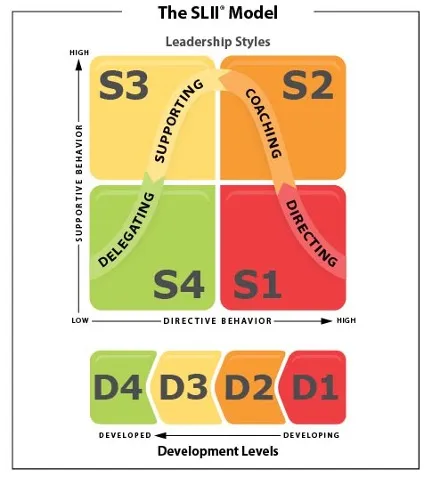In this series on leadership theories, we have already looked at early ideas such as the Great Man theory, Control and Domination and Leadership Traits. As research into leadership developed, studying leadership skills led to looking at the behaviours (behavioural leadership) and actions of leaders. (Action-Centred Leadership).
It was now recognised that leadership can take different forms. Therefore, studies were made into which situations certain leaders thrived in. This led to various theories of situational leadership.
Situational Leadership Theory
For example, Fiedler (1967), argued that there was no one right way to lead, but rather that the type of leader and style of leadership needed to suit the situation.Sometime later on, Paul Hersey and Ken Blanchard (author of The One Minute Manager) developed a model situational leadership that many people will be familiar with.
Blanchard and Hersey’s Situational Leadership Model
This model helps to show the most appropriate form of leadership, depending upon the nature of the task and the competency and commitment of the team. In simple terms it breaks down into four key leadership approaches:
- Directive – telling people what to do, usually used for enthusiastic novices
- Delegating – giving over whole tasks to people who are experienced and able to take responsibility. This is a more hands-off leadership approach
- Supporting – this is when there is a high level of trust in the team and individuals can manage themselves independently. But the leader has higher participation than in pure delegation, by providing moral support, encouraging and communicating proactively
- Coaching – this involves selling the task to the individual and helping them grow to take on more responsibility. This works particularly well with individuals who may have lost confidence in what they need to do
The following diagram summarises the Blanchard model:

Ken Blanchard’s Situational Leadership Model
Team Member Development and Maturity Levels
As well as the four leadership styles in the model there are also four development levels that relate to the maturity and capability of the team members. In the model these progress from D1, at the low end of maturity and development, to D4, where the person is highly capable to deal with the task.
It is important to remember that someone could be very experienced generally but, faced with a new task, they could find themselves out of their depth. Therefore, as a manager, it is important to think about someone’s ability to do the specific task and how to lead them in that situation rather than just the usual default approach.
For example, I have worked with CEOs who are incredibly experienced and gifted but who have required coaching support as their roles and organisations have evolved. It is an important lesson in humility for all leaders as well as team members. It does not matter how capable we are (or think we are), there will always be times where we are learners and need people to support us.
Situational Leadership Examples
I have found this situational leadership model useful in helping to understand how I can adapt my leadership style, depending on the situation. It has also assisted me in identifying my preferred approaches.
Delegating and Supporting
It has been my privilege to work with and lead some really experienced and capable teams. Therefore, a much as possible, I like to adopt a more non-directive leadership approach. I also like to be led this way and generally be left to get on with things (S4). Because I tend towards being a hands-off leader, I have learned to communicate this to teams early. I let them know that they can ask questions and, if necessary, demand more support from me (S3).
Coaching
When I see an individual who needs help, I trend towards a coaching style (S2). I really enjoy going with people on their learning journey. Seeing people confident and empowered is hugely motivating for me and that is a big reason why I actively coach leaders alongside my other leadership responsibilities.
Directing and Commanding
I keep the more directive approach (S1) for times of real crisis. Generally, I don’t tend to stay in this mode for long. My children might argue and say, “Daddy, you are always ordering me around!” But, in my defence, I would argue that if you visited our house around bedtime, it is a crisis zone!
I have used this command style of leadership at times in the military, which might be an obvious example. But it has also been critical to other situations. I have used this style when leading teams off mountains in bad weather and when reacting quickly to bad news in a business context. This directive style can be a reassuring approach in a crisis. However, it quickly becomes overbearing if used all the time, particular with an able team.
To be a Leader is to be a Learner
No matter where we are on our journey we can all discover something new about leadership. It does not even matter how much responsibility we have (or don’t have). Everyone can learn to lead better and flex their leadership style for different situations. The best leaders are not stuck in one mode of management all the time.
So think about your team and their tasks today. As a manager, do you need to direct, delegate, support or coach them through their next piece of work?




